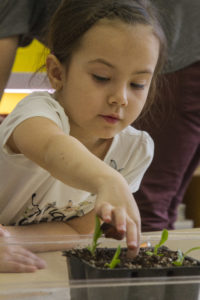We have much more to do and your continued support is needed now more than ever.
Kindergarteners Help Grow a Wild Brooklyn

My class, as well as 11 other NWF Eco-Schools, has not only been learning about monarch butterflies and other pollinators, but also growing native plants as part of the NYC Eco-Schools’ Growing a Wild Brooklyn and Queens habitat restoration program. The milkweed, along with other pollinator-friendly plants that we are growing in our classroom, is destined for a pollinator garden at Jamaica Bay Wildlife Refuge in Queens.
But it’s not just the pollinators who are benefiting. My 19 kindergarteners, with their boundless energy, enthusiasm and curiosity, are too. Our project has brought them out into the fresh air to a natural parkland with views of New York City among its bat houses and osprey nests. It has allowed them to get their hands dirty and think about how they can help nature. And, it has given me countless of extension ideas. We have traced monarch butterflies’ migratory paths from the Northeast to the fir tree forests in Mexico on Google Earth and we have created faux stain glass butterflies for our classroom windows. Of course, we have read lots of books. When it came time for them to write their own non-fiction books, many of my students turned to a topic they knew a lot about — butterflies.

Michelle and Michael also brought us a tray of primrose seedlings. We had picked primrose seeds when we visited Jamaica Bay in October, so, it was very exciting for the class to see the little plants shooting up. The primrose and the milkweed were set under grow lights, which were given to us as part of the “Wild” program.


“We are little gardeners, right, Mrs. Campanie?” one of my students has said to me a couple of times. “Yes,” I tell her, and she smiles broadly. Her queries showed me that in addition to the environmental and educational benefits, our pollinator project is bringing happiness to the little gardeners in the room.
You, too, can create your own pollinator project by planting native species in your gardens, schools, and community spaces. Learn how to garden for wildlife to help reestablish pollinator populations such as the monarch butterflies.
![]() Join NWF in becoming a Butterfly Hero today and NWF will send you a free native milkweed kit to help you get your wildlife garden started!
Join NWF in becoming a Butterfly Hero today and NWF will send you a free native milkweed kit to help you get your wildlife garden started!
The Growing a Wild Brooklyn and Queens program is a partnership between the National Park Service/Gateway National Recreation Area, National Wildlife Federation NYC Eco-Schools, Greenbelt Native Plant Center, the NYC Department of Education, the Student Conservation Association, the Community Greenways Collaborative, Brooklyn College and local seniors.
 About the Author: Mina Campanie is a kindergarten teacher at P.S. 197, The Kings Highway Academy in Brooklyn, NY. She sees many similarities between caring for her seedlings at home and nurturing the kindergarteners at school. This is her fourth year of teaching.
About the Author: Mina Campanie is a kindergarten teacher at P.S. 197, The Kings Highway Academy in Brooklyn, NY. She sees many similarities between caring for her seedlings at home and nurturing the kindergarteners at school. This is her fourth year of teaching.






















